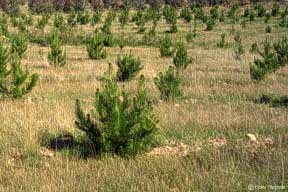|
|
|
Watering and irrigation

If trees are planted into moist soils during
the wet season, and weed control is good, then initial watering
is rarely needed for survival and early growth. However, in
very sandy soils, or in the tropics where there is a risk
of the soils drying out quickly, follow-up watering might
be necessary to avoid large losses. The risk is greatest for
open rooted plants or those in very small cells or pots. If
planting out-of-season, it might be better to consider using
tube-stock in larger pots.
If concerned, the grower can add about 100 millilitres of
water to the planting hole and allow this to soak in prior
to planting. It is good practice to make sure the seedlings
are very well watered before planting and this should be sufficient
in most cases. Where weed control is done well before planting,
the risk of having dry sub-soil is reduced. Subsequent watering
in the months following planting can reduce, rather than enhance,
long term survival. Rather than encourage surface rooting
by watering it is better to encourage deeper root development
in the young trees as they search for sub-soil moisture.
In areas where the water supply is limited, irrigation is
expected to enhance tree growth and production. The use of
plantations as a mean of using wastewater has been widely
researched in Australia. The results suggest that not only
can growth rates be increased but that irrigation can also
foster the growth of species that would not normally do well
in particular areas. There are fewer examples of growers using
fresh water to irrigate plantations for timber production.
While much can be learnt from wastewater treatment trials
there are also many uncertainties facing growers who need
to pay for their water. These include the effect of intermittent
watering, or missed seasons when irrigation did not occur,
on tree health, stand growth and wood quality. There is a
risk that surface irrigation will increase the shoot/root
ratio and encourage shallow rooting. This can result in a
greater risk of toppling in strong winds and drought deaths.
Effluent Plantations
Back to top
|
